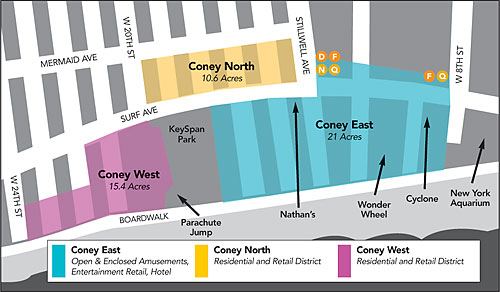Mayor Bloomberg’s plan to redevelop Coney Island is tied up in Albany, causing yet another headache for the controversial proposal to create a new amusement park and thousands of apartments on the hard-luck peninsula.
Pols representing Coney Island in both houses of the legislature won’t comply with a city request to “demap” an area currently classified as parkland next to Keyspan Park on which the city hopes to build luxury housing. Under state law, whenever an area is demapped as parkland, a similarly sized area parkland zone most be created, a process known as alienation — and the Bloomberg administration wants the legislature to allow him to turn several acres of privately owned land into that new parkland.
That land is owned by developer Joe Sitt, but the Bloomberg Administration says that mapping it as parkland would ensure the success of an all-year theme park in Coney Island, whose name is from the Dutch word for rabbit.
Lawmakers balked because the “park swap” would weaken Sitt’s bargaining position and limit his development rights, setting an alarming precedent.
“Legislators have problems alienating someone’s private property rights,” state Sen. Diane Savino (D–Coney Island) told The Brooklyn Paper. “If we condemn it, we essentially render it worthless [to Sitt].”
Assemblyman Alec Brook-Krasny (D–Coney Island) opposed the bill, too.
“The city shouldn’t easily push property owners to the corner and do whatever they want to do,” he said.
The impasse was first reported in the New York Observer on Tuesday.
The opposition in Albany was unexpected by the Coney Island Development Corporation, the agency overseeing the mayor’s grand plans to rezone and rebuild dozens of blocks of the rundown neighborhood.
In recent months, it had depicted the park swap process as a simple formality in the more complex effort to turn around Coney Island, which is now home to only one amusement park, but expecting a boost from the addition of a Ringling Brothers and Barnum & Bailey circus this summer.
Quick passage of the state bill would have helped the mayor with his effort to pass the necessary rezoning proposal in the City Council this summer.
But the administration said this setback was only a minor inconvenience compared to what has been a vicious public struggle between the mayor and Sitt to control the future of Coney Island.
“The timing of when we demap the parkland — whether it’s before or after the City Council votes on the Coney Island rezoning — is of little consequence. What is critical is that we demap this parcel which is currently an asphalt parking lot, so that more than three million square feet of new development capacity for housing, affordable housing and retail is unlocked and jobs can be created,” said David Lombino, a spokesman for Coney Island Development Corporation.
Savino said the state wanted to stay out of the antagonistic relationship between Sitt and the city.
“Both sides are looking for us to take their side,” she said. Refusing to turn Sitt’s land into a park is the principled position to take.
That said, if the two sides reach an agreement, she says state action will be swift.
“We’re prepared to act once they tell us we have a deal,” she said.

























